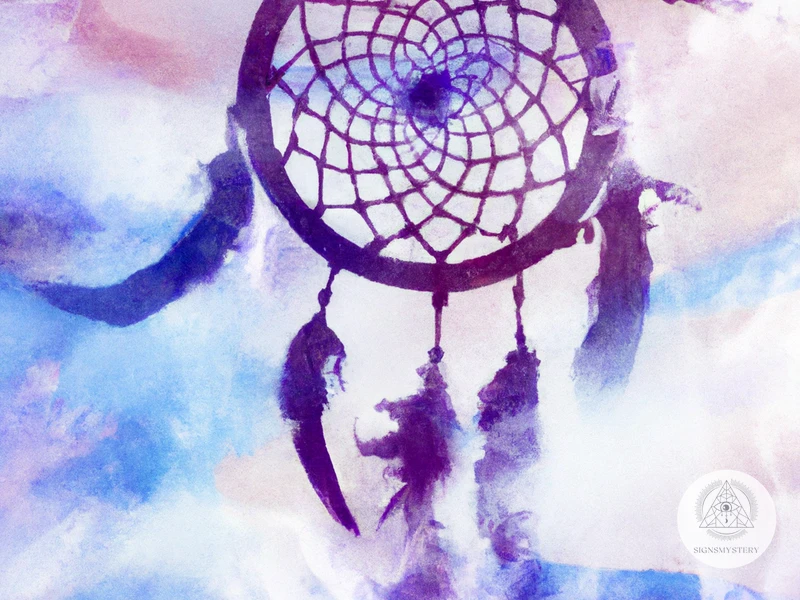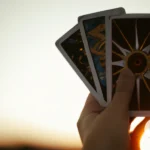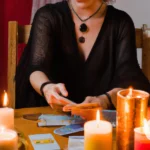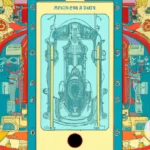As humans, we are all imbued with a sense of curiosity and wonder about the unknown depths of our minds. The vast, inexplicable realm of the unconscious is something that has fascinated us for centuries. In the realm of tarot card readings, understanding the collective unconscious can unlock a new level of depth and insight into the cards’ meaning. But what exactly is the collective unconscious, and how can it affect our interpretations of the Tarot’s archetypes? Through exploring techniques for harnessing the collective unconscious, we can unlock an even deeper connection to the world of tarot reading.
Understanding the Collective Unconscious

The world of tarot card readings is a fascinating one, steeped in symbolism and archetypes that speak to our subconscious minds. One concept that is particularly important to understand when delving into the world of tarot and its deeper meanings is the collective unconscious. This term, coined by renowned psychologist Carl Jung, refers to the shared pool of instinctive and unconscious knowledge that all humans possess. This knowledge is filled with universal symbols and themes that transcend individual experience, and it plays a crucial role in tarot readings. In this section, we’ll explore the concept of the collective unconscious and its importance in interpreting tarot cards. To learn more about the archetypes that are part of the collective unconscious, see our article on tarot archetypes in Jungian psychology.
What is the Collective Unconscious?
The concept of collective unconscious was introduced by Carl Jung, a Swiss psychiatrist and psychoanalyst, as a part of his theory of analytical psychology. According to Jung, the collective unconscious is a universal aspect of the psyche that is shared by all human beings, representing the accumulated knowledge and experience of our ancestors.
Jung believed that the collective unconscious was composed of various archetypes, which are universal symbols or patterns that have been present in human culture throughout history. These archetypes are represented in many different forms, including myths, religions, art, and literature.
In a Tarot card reading context, the collective unconscious refers to the vast pool of shared symbols, meanings, and archetypes that are present in the Tarot deck. These symbols and archetypes can be interpreted in a variety of ways, depending on the individual, their experiences, and their particular approach to Tarot reading.
Understanding the collective unconscious is essential to a fully Jungian interpretation of the Tarot. Jung believed that through an exploration of the collective unconscious and its archetypes, individuals could gain greater insight into their own lives and experiences, leading to self-discovery and personal growth.
How does it relate to Tarot Card Readings?
The concept of collective unconscious is fundamental to the understanding of tarot card readings. This is because both concepts are rooted in the ideas of the Swiss psychologist Carl Jung. The concept of the collective unconscious is central to Jungian psychology and is believed to be a storehouse of shared human experiences and archetypal symbols. Similarly, tarot cards use archetypes and symbols that are believed to have universal meaning and can tap into the collective unconscious.
Tarot card readings involve accessing the collective unconscious to gain insights into individual lives. The symbols and archetypes used in tarot are believed to have universal meanings and can tap into the collective unconscious. Understanding the collective unconscious can help tarot readers to gain a deeper understanding of the cards and to interpret them more effectively.
The symbols and archetypes used in tarot cards are representative of the collective unconscious. By tapping into the collective unconscious, tarot readers can get a better understanding of the symbols they are seeing in the cards. For example, the archetype of the “Fool” in the tarot represents new beginnings and taking risks. This is an archetype that is rooted in the collective unconscious and can provide insights into a sitter’s situation.
The collective unconscious is where the Shadow Self resides, which is another concept that is central to Jungian psychology and is also a crucial part of tarot readings. The Shadow Self refers to the dark or hidden parts of ourselves that we may be unaware of or try to repress. The tarot can be used as a tool for exploring the Shadow Self and bringing these repressed parts to the surface.
The collective unconscious is an essential aspect of tarot card readings as it helps to provide insights and a deeper understanding of the symbols and archetypes used in the cards. By tapping into the collective unconscious, tarot readers can provide more effective and meaningful readings for their sitters.
Examples of Archetypes
Archetypes are universal patterns of human behavior and experience. These patterns are deeply ingrained in our collective unconscious, and they often manifest in Tarot card readings. Some common archetypes that appear in Tarot readings include:
- The Fool: This archetype represents new beginnings, optimism, and naivete. It can also symbolize taking risks and embracing the unknown.
- The Magician: This archetype is all about harnessing one’s personal power and creativity to achieve one’s goals. It can also represent manipulation and deception.
- The High Priestess: This archetype represents intuition, mysteries, and secrets. It can also symbolize hidden knowledge and spiritual enlightenment.
- The Empress: This archetype embodies femininity, nurturing, and abundance. It can also represent creative fertility and sensual pleasure.
- The Emperor: This archetype represents authority, structure, and stability. It can also symbolize control and rigidity.
- The Hierophant: This archetype represents tradition, conformity, and organized religion. It can also represent dogmatism and cultural oppression.
- The Lovers: This archetype represents relationships, connection, and choice. It can also symbolize temptation and heartbreak.
- The Devil: This archetype embodies temptation, indulgence, and addiction. It can also represent materialism and selfishness.
- The Tower: This archetype represents chaos, upheaval, and dramatic change. It can also symbolize destruction and the breaking down of old structures.
- The Star: This archetype represents hope, inspiration, and guidance from a higher power. It can also symbolize unrealistic expectations and disappointment.
These archetypes are just a few examples of the many patterns that can be observed in Tarot card readings. By understanding these archetypes and their meanings, Tarot readers can gain deeper insights into the messages conveyed by the cards. For more information on the connection between Tarot and Jungian psychology, check out this article about Tarot and Jungian interpretation.
How the Collective Unconscious Affects Tarot Readings
As we delve deeper into the world of tarot readings, we discover the significant impact of the collective unconscious on this mystical practice. The collective unconscious, as explored by Carl Jung, is a vast repository of archetypes and symbols that are present in every human being’s subconscious. Understanding how this collective unconscious affects tarot readings can be enlightening and insightful, particularly in deciphering the symbols and archetypes present in the cards. This intricate relationship between the collective unconscious and tarot readings underscores the importance of acknowledging the role of the self in the interpretation of these readings. To further understand how the collective unconscious shapes tarot readings, let us explore its influence on interpretation, connection, and insights.
Influence on Interpretation
The interpretation of tarot cards is heavily influenced by the collective unconscious. This is because the archetypes which form the collective unconscious are present in the images and symbols on the cards. Tarot cards serve as a tool for accessing these archetypes, and interpreting their meanings can offer valuable insights.
When reading tarot cards, the collective unconscious can affect the interpretation of the cards in several ways:
- Universal themes: The archetypes in the collective unconscious represent universal themes and experiences that are common to all humanity. These themes are often present in the tarot cards, and can influence the interpretation of the cards.
- Shared symbols: The collective unconscious contains a wealth of shared symbols and motifs that have been passed down through generations. Many of these symbols are present in the images on tarot cards, and can be used to gain insights into the meanings of the cards.
- Subconscious associations: The collective unconscious is made up of the sum total of all human experience, both conscious and unconscious. When interpreting tarot cards, the reader’s own personal associations with the symbols on the cards can be influenced by the collective unconscious.
The collective unconscious can also influence the spread of tarot cards. Certain spreads, such as the Celtic Cross, are steeped in archetypal symbolism and are deeply rooted in the collective unconscious. This can allow the reader to tap into the wisdom of the collective unconscious and gain deeper insights into the meaning of the cards.
The influence of the collective unconscious on interpretation highlights the importance of understanding the archetypes and symbols present in the tarot cards. By delving into the collective unconscious and exploring its many facets, it’s possible to gain a deeper understanding of the cards and their meanings. For more information on the connection between the collective unconscious and tarot readings, visit tarot self-discovery using Jungian psychology.
Influence on Connection
Influence on Connection
One of the most significant influences that the collective unconscious has on Tarot readings is the connection between the reader and the querent. This connection is more than just a simple conversation or exchange of energy – it is a link that occurs at a deeper level, where the reader is able to tap into the querent’s unconscious mind and draw out insights that may not be immediately apparent.
This connection is often described as a sort of symbiotic relationship, in which the reader and the querent work together to uncover hidden truths and insights. The collective unconscious plays a powerful role in this connection, as it provides a sort of bridge between the two individuals, allowing them to access the archetypes and symbols that reside within their shared human experience.
Through this connection, the reader is able to tap into the collective unconscious and access a range of ancient symbols and archetypes that can provide a deeper understanding of the querent’s situation. For example, if a querent is struggling with relationship issues, the reader may tune into the archetype of the “lover,” and use this energy to gain insights into the querent’s own experiences and challenges.
In addition to helping the reader understand the querent’s situation, this connection can also provide a sense of validation and empathy. By tapping into the collective unconscious, the reader is able to access a deeper level of understanding and compassion, which can help create a sense of trust and openness between the two individuals.
The influence of the collective unconscious on the connection between a Tarot reader and querent is a powerful force that can help unlock hidden truths and insights. By acknowledging and harnessing this force, readers can create a more meaningful and impactful Tarot experience for themselves and their clients.
To deepen the connection between reader and querent, explore the importance of the shadow self in Tarot readings or consider the concept of numerology in Tarot to add an additional layer of meaning to the cards.
Influence on Insights
The collective unconscious can have a significant impact on the insights gained from a tarot card reading. By tapping into the shared experiences and symbolic imagery stored within the collective unconscious, tarot readers can gain deeper insights into the querent’s situation.
One way this can manifest is through the appearance of archetypal symbols in the cards. Archetypes are abstract concepts or universal symbols that are deeply ingrained in the collective unconscious. These symbols can appear in the form of people, events, or objects, and can be interpreted in a multitude of ways.
Influence on Interpretation
The collective unconscious can also influence the interpretation of the cards. For example, if a reader is conducting a reading for a querent who is struggling with a decision, the cards may reveal archetypes of choice and change. The reader may interpret these symbols as a message from the collective unconscious to embrace change and take a leap of faith in making a decision.
Influence on Connection
The collective unconscious can also enhance the connection between the reader and querent. If both parties are open and receptive to the symbols and archetypes presented in the cards, they can create a deeper connection by recognizing shared experiences and patterns. This connection can foster trust and empathy, leading to a more fruitful reading experience.
Influence on Insights
By tapping into the collective unconscious, tarot readers can gain unique insights into the querent’s situation. The symbols and archetypes presented in the cards can reveal hidden knowledge or deeply rooted emotions that the querent may not have been aware of. This new information can provide clarity and guide the querent towards making positive changes in their life.
The collective unconscious plays a vital role in tarot card readings. By harnessing the power of shared experiences and symbols, tarot readers can gain deeper insights into the querent’s situation and provide guidance for positive change.
| Influence on Interpretation | The collective unconscious can influence the interpretation of the cards and reveal archetypes that provide a message for the querent. |
|---|---|
| Influence on Connection | The collective unconscious can enhance the connection between the reader and querent by revealing shared experiences and patterns. |
| Influence on Insights | The collectiveSubscribe to Our NewsletterSign up to receive the latest news and updates. |
Techniques for Harnessing the Collective Unconscious
As we begin to delve deeper into tarot card readings, it becomes evident that there is a vast wellspring of information available to us through the collective unconscious. However, accessing this information requires a certain level of skill and practice. In this section, we will explore various techniques that can be used to harness the power of the collective unconscious in tarot card readings. From meditation and visualization to dream journaling and symbol exploration, we’ll examine each method in detail, and consider how each can help to shed light on the archetypes and symbolic language of the tarot. So, if you are ready to take your tarot practice to the next level, read on to discover these powerful techniques for tapping into the collective unconscious.
Meditation and Visualization
Meditation and visualization are powerful tools that can help Tarot readers tap into the collective unconscious. Through quiet reflection and visualization, a reader can better connect with their intuition and gain a deeper understanding of the archetypes present in the Tarot.
Meditation:
Meditation involves sitting in silence and focusing on the present moment. It can help quiet the mind and reduce distractions, allowing the Tarot reader to better connect with their inner self and the collective unconscious. There are different types of meditation, but beginners may find it helpful to start with a simple breathing exercise.
Visualization:
Visualization involves creating mental images that can help the reader connect with the symbolism of the Tarot. It can be helpful to visualize the meaning of specific cards before or during a reading. For example, if the reader is struggling to interpret the meaning of the Tower card, they could visualize a crumbling tower or a lightning bolt striking a tower. This can help the reader gain deeper insight into the card and its significance.
Combining Meditation and Visualization:
Meditation and visualization can be combined for a powerful effect. The reader could begin with a short meditation to quiet the mind and then move into a visualization exercise, focusing on a specific card or archetype. This can help the reader gain insights into the symbolism of the Tarot and make connections that might not be apparent otherwise.
Tips for Successful Meditation and Visualization:
- Practice regularly: Consistency is key when it comes to meditation and visualization. Aim to practice daily, even if it’s only for a few minutes.
- Create a comfortable environment: Find a quiet, peaceful place where you can meditate without distractions. Make sure you’re sitting comfortably and use cushions or a yoga mat if necessary.
- Set an intention: Before you begin, set an intention for your meditation and visualization practice. This could be a specific question or issue you want to explore or a general desire to connect with your intuition.
- Use guided meditations: If you’re new to meditation or visualization, consider using guided meditations that walk you through the process.
- Be patient: Like any skill, it takes time and practice to develop your meditation and visualization abilities. Be patient and kind to yourself as you explore this powerful tool.
Using meditation and visualization techniques can enhance the Tarot reading experience and help readers tap into the collective unconscious. By practicing regularly and being patient, readers can gain deeper insights into the symbolism and archetypes present in the Tarot.
Dream Journaling
One of the most intriguing ways to explore the collective unconscious during tarot card readings is through dream journaling. Dreams can often be a message from the collective unconscious, filled with symbols and archetypes waiting to be interpreted. Here are some steps to help you get started with dream journaling:
| Step | Description |
|---|---|
| 1. | Keep a journal by your bed: Start by keeping a notebook or journal by your bed. This way, you can easily jot down your dreams upon awakening. |
| 2. | Write down your dreams: Write down as much as you can remember about your dream, including any symbols or archetypes that stand out to you. |
| 3. | Reflect on your dream: Spend some time reflecting on your dream and the symbols within it. Consider the emotions you felt during your dream and any connections you can draw to your waking life. |
| 4. | Interpret your dream: Use your knowledge of archetypes and symbols to interpret your dream. Consider what message the collective unconscious may be trying to send you. |
| 5. | Use your dream in a tarot reading: If you are doing a tarot card reading, consider incorporating the symbols and archetypes from your dream into your reading. These can provide additional insight into the question at hand. |
By keeping a dream journal and exploring the symbols and archetypes within your dreams, you can tap into the collective unconscious and gain a deeper understanding of yourself and the world around you.
Symbol Exploration
One technique for harnessing the collective unconscious in tarot card readings is symbol exploration. Symbol exploration involves taking a closer look at the symbols within the tarot cards and exploring their deeper meanings. This technique can help readers tap into the collective unconscious and gain new insights into the reading.
Here are some steps to follow for conducting symbol exploration in your tarot readings:
Step 1: Choose a card that you would like to explore further.
Step 2: Look at the symbols within the card. Take note of any images or objects that stand out to you.
Step 3: Write down or draw the symbols that you have identified. Be sure to capture any thoughts or feelings that come up as you explore the symbols.
Step 4: Research the symbols that you have identified. Look for any historical or cultural significance of the symbol. Consider how the symbol has been used in literature, art, or other areas of life.
Step 5: Reflect on the symbol and its meaning. Consider how it could relate to the question at hand or the overall theme of the tarot reading.
Step 6: Use your insights to enhance your interpretation of the card. Consider how the symbol could provide deeper meaning or shed light on a particular aspect of the reading.
By exploring the symbols within the tarot cards through symbol exploration, readers can gain a deeper understanding of the collective unconscious and its influence on tarot readings. This technique can be particularly useful for readers who are looking to refine their interpretive skills or gain new insights into difficult readings.
Conclusion
In conclusion, the concept of the collective unconscious is an integral part of tarot card readings, influencing interpretation, connection, and insights. By understanding and harnessing the power of archetypes, symbolism, and intuition, tarot readers can gain deeper insight into the collective unconscious and provide more meaningful readings for their clients.
One key technique for accessing the collective unconscious is through meditation and visualization. By quieting the mind and focusing on imagery, readers can tap into their intuition and gain a greater understanding of the energy surrounding a situation or question.
Another technique is dream journaling, which involves recording and reflecting on dreams to uncover underlying emotions and archetypes. Dreams provide a direct line to the unconscious mind, and can reveal powerful insights that can be incorporated into a tarot reading.
Finally, exploring symbolism and archetypes is essential for connecting with the collective unconscious. By studying and meditating on the significance of common symbols and archetypes such as the Fool or the High Priestess, tarot readers can gain a deeper appreciation for the patterns and energy at work in their readings.
Overall, the collective unconscious represents an expansive and fascinating realm of exploration for tarot readers. By embracing and working with the archetypes and symbolism of the collective unconscious, readers can deepen their insights and provide empowering guidance for their clients.
Frequently Asked Questions
What is the origin of Tarot Cards?
Tarot Cards originated in Italy in the 15th century as a card game.
Do I have to believe in the Collective Unconscious for Tarot readings to work?
No, you do not have to believe in the Collective Unconscious for Tarot readings to work. However, understanding this concept may help you gain deeper insights into the cards.
What are some common archetypes in Tarot cards?
Some common archetypes in Tarot cards include The Fool, The Magician, The High Priestess, The Empress, The Emperor, The Hierophant, The Lovers, The Chariot, The Hermit, and The World.
Can anyone learn to read Tarot cards?
Yes, anyone can learn to read Tarot cards with dedication and practice.
Is Tarot reading considered a form of divination?
Yes, Tarot reading is considered a form of divination used for gaining insights and guidance.
What is the difference between the conscious mind and the unconscious mind?
The conscious mind is the part of the mind that is responsible for awareness, decision making, and logical thinking. The unconscious mind is the part of the mind that holds repressed emotions, memories, and instincts.
How can I connect with my own unconscious mind?
You can connect with your own unconscious mind through practices such as meditation, dream journaling, and symbol exploration.
What is symbolism and why is it important in Tarot readings?
Symbolism is the use of symbols or images to represent ideas, concepts, or meanings. It is important in Tarot readings because the cards are full of symbolic images that can provide insights and guidance.
How do Tarot cards work?
Tarot cards work as a tool for accessing and interpreting the collective unconscious, providing insights and guidance for the individual seeking answers.
Can Tarot cards predict the future?
Tarot cards cannot predict the future with certainty, but they can provide guidance and insights into potential outcomes. The future is ultimately influenced by the individual’s own choices and actions.










